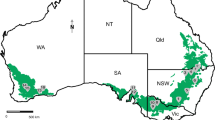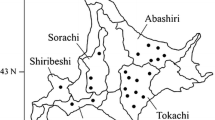Abstract
Barley net blotch is one of the most widespread and destructive foliar diseases of barley crops worldwide. The causal fungal agent, Pyrenophora teres (anamorphic stage: Drechslera teres) occurs in two forms, P. teres f. maculata (Ptm) and P. teres f. teres (Ptt) exhibiting the spot and net type symptoms, respectively. In this study, sixty-one P. teres single conidia isolates were obtained from different cereal-growing areas in Algeria. Fungal isolates of net and spot forms were identified using appropriate form-specific SNP primers. The results indicated that 57.38% of the isolates were Ptm, while 42.62% were identified as Ptt. Mating-type assessments of P. teres isolates were conducted using MAT-specific single nucleotide polymorphism primers. Among the tested strains of Ptt, 19 were found as MAT1-2 and only 7 were determined as MAT 1–1; while 27 were identified as MAT 1–1, and 8 were found as MAT1-2 for the Ptm population. Inter-simple sequence repeat markers (ISSR) were used to examine genetic variation and relationships within the P. teres population. The similarity rates were found as 0.60 and 0.63 within Ptt and Ptm populations, respectively. Our results suggested that both populations are reproducing sexually. It appears that P. teres f. teres population is reproducing exclusively sexually and P. teres f. maculata population is reproducing mostly sexually, but asexual reproduction is also occurring. Obviously, ascospore production is a key epidemiological aspect, but in the case of P. teres f. maculata, conidia may also be playing a role.






Similar content being viewed by others
References
Akar T, Avci M, Dusunceli F (2004) Barley: Post-harvest operations. Food and Agriculture Organization of the United Nations
Akhavan A, Turkington TK, Kebede B, Tekauz A, Kutcher HR et al (2015) Prevalence of mating type idiomorphs in Pyrenophora teres f. teres and P. teres f. maculata populations from the Canadian prairies. Can J Plant Pathol 37:52–56. https://doi.org/10.1080/07060661.2014.995710
Allen GC, Flores-Vergara MA, Krasynanski S, Kumar S, Thompson WF (2006) A modifed protocol for rapid DNA isolation from plant tissues usingcetyltrimethylammonium bromide. Nat Protoc 1:2320–2325. https://doi.org/10.1038/nprot.2006.384
Bakonyi J, Justesen AF (2007) Genetic relationship of Pyrenophora graminea, P. teres f. maculata and P. teres f. teres assessed by RAPD analysis. J Phytopathology 155:76–83. https://doi.org/10.1111/j.1439-0434.2007.01192.x
Baturo-Ciesniewska A, Grabowski A, Panka D (2012) Diversity in the polish isolates of Drechslera teres in spring barley as determined through morphological features, mating types, reaction to control agents and RAPD markers. J Plant Pathol 94:339–351. https://doi.org/10.4454/JPP.FA.2012.037
Boungab K, Belabid L, Fortas Z (2011) Recherche de géniteurs de résistance à la rayure réticulée de l'orge causée par Pyrenophora teres. In : Proceedings du 4ème Conférence Internationale sur les Méthodes Alternatives en Protection des Cultures, Lille, France, pp 156–163
Boungab K, Belabid L, Fortas Z, Bayaa B (2012) Pathotype diversity among Algerian isolates of Pyrenophora teres f. teres. Phytopathol Mediterr 51:577−586. https://doi.org/10.14601/Phytopathol_Mediterr-10561
Campbell GF, Lucas JA, Crous PW (2002) Evidence of recombination between net- and spot-type populations of Pyrenophora teres as determined by RAPD analysis. Mycol Res 106:602–608. https://doi.org/10.1017/S0953756202005853
Çelik Oğuz A, Ölmez F, Karakaya A (2018) Mating type idiomorphs of Pyrenophora teres in Turkey. Zemdirbyste-Agriculture 105:271–278. https://doi.org/10.13080/z-a.2018.105.035
Çelik Oğuz A, Ölmez F, Karakaya A (2019) Genetic diversity of net blotch pathogens of barley in Turkey. Intl J Agric Biol 21:1089–1096. https://doi.org/10.17957/IJAB/15.0998
Ellwood SR, Piscetek V, Mair WJ, Lawrence JA, Lopez-Ruiz FJ et al (2019) Genetic variation of Pyrenophora teres f. teres isolates in Western Australia and emergence of a Cyp51A fungicide resistance mutation. Plant Pathol 68:135–142. https://doi.org/10.1111/ppa.12924
Ficsor A, Tóth B, Varga J, Csosz M, Tomcsányi A et al (2014) Variability of Pyrenophora teres f. teres in Hungary as revealed by mating type and RAPD analyses. J Plant Pathol 96:515–523
Jalli M, Robinson J (2000) Stable resistance in barley to Pyrenophora teres f. teres isolates from the Nordic -Baltic region after increase on standard host genotypes. Euphytica 113:71–77. https://doi.org/10.1023/A:1003912825455
Jordan VWL (1981) Aetiology of barley net blotch caused by Pyrenophora teres and some effects on yield. Pl Path 30:77–87. https://doi.org/10.1111/j.1365-3059.1981.tb01232.x
Karakaya A, Katırcıoğlu YZ, Aktaş H (2004) Studies on the biology of Drechslera teres under Ankara conditions. Tarim Bilim Derg (journal of Agricultural Sciences) 10:133–135
Lammari H-I, Rehfus A, Stammler G, Fellahi ZEA, Benbelkacem A et al (2019) Occurrence and frequency of spot form and net form of net blotch disease of barley in Algeria. J Plant Dis Prot 127:35–42. https://doi.org/10.1007/s41348-019-00278-w
Lehmensiek A, Bester-van der Merwe AE, Sutherland MW, Platz G, Kriel WM et al (2010) Population structure of South African and Australian Pyrenophora teres isolates. Plant Pathol 59:504–515. https://doi.org/10.1111/j.1365-3059.2009.02231.x
Linzer RE, Rizzo DM, Cacciola SO, Garbelotto M (2009) AFLPs detect low genetic diversity for Phytophthora nemorosa and P. pseudosyringae in the US and Europe. Mycol Res 113(3):298–307. https://doi.org/10.1016/j.mycres.2008.11.004
Liu Z, Ellwood SR, Oliver RP, Friesen TL (2011) Pyrenophora teres: profile of an increasingly damaging barley pathogen. Mol Plant Pathol 12:1–19. https://doi.org/10.1111/j.1364-3703.2010.00649.x
Lu S, Platz GJ, Edwards MC, Friesen TL (2010) Mating type locus-specific polymerase chain reaction markers for differentiation of Pyrenophora teres f. teres and P. teres f. maculata, the causal agents of barley net blotch. Phytopathology 100:1298–1306. https://doi.org/10.1094/PHYTO-05-10-0135
Mcdonald BA, Linde C (2002) Disease resistance and pathogen population genetics. Plant Prot Sc 38:245–248
Mclean MS, Howlett BJ, Hollaway GJ (2010) Spot form of net blotch, caused by Pyrenophora teres f. maculata, is the most prevalent foliar disease of barley in Victoria. Australia Australas Plant Pathol 39:46–49
Mclean MS, Howlett BJ, Hollaway GJ (2009) Epidemiology and control of spot form of net blotch (Pyrenophora teres f. maculata) of barley: a review. Crop Pasture Sci 60:303–315. https://doi.org/10.1071/CP08173
Murray TD, Parry DW, Cattlin ND (2009) Diseases of small grain cereal crops: a colour handbook. Manson publishing, London
Peever TL, Milgroom MG (1994) Genetic structure of Pyrenophora teres populations determined with random amplified polymorphic DNA markers. Can J Bot 72:915–923. https://doi.org/10.1139/b94-116
Rau D, Brown AHD, Brubaker CL, Attene G, Balmas V et al (2003) Population genetic structure of Pyrenophora teres Drechs. the causal agent of net blotch in Sardinian landraces of barley (Hordeum vulgare L.). Theor Appl Genet 106:947–959. https://doi.org/10.1007/s00122-002-1173-0
Robinson J, Mattila I (2000) Diversity and difference within and between Pyrenophora teres f. teres populations measured with Kosman’s indices. Arch Phytopath Pflanz 33:11–23. https://doi.org/10.1080/03235400009383324
Rohlf FI (1998) Ntsys-pc. Numerical taxonomy and multivariate analysis system version 2.0. Applied Biostatistics Exeter Software, New York, USA
Sayoud R, Ezzahiri B, Bouznad Z (1999) Les maladies des céréales et des légumineuses alimentaires au Maghreb. ITGC, Alger
Serenius M, Mironenko N, Manninen O (2005) Genetic variation, occurrence of mating types and different forms of Pyrenophora teres causing net blotch of barley in Finland. Mycol Res 109:809–817. https://doi.org/10.1017/S0953756205002856
Smedegård-Petersen V (1971) Pyrenophora teres f. maculata f. nov and Pyrenophora teres f. teres on barley in Denmark. Yearb R Vet Agric Univ, Copenhagen, Denmark: 124–144
Statkevičiūtė G, Brazauskas G, Semaškienė R, Leistrumaitė A, Dabkevičius Z (2010) Pyrenophora teres genetic diversity as detected by ISSR analysis. Zemdirbyste Agriculture 97:91–98
Teferi TA, Wubshet ML, Aregawi TB (2015) Occurrence and intensity of net and spot blotch of barley in South Tigray, Ethiopia. Glob J Pests Dis Crop Prot 3:113–123
Tekauz A (1990) Characterization and distribution of pathogenic variation in Pyrenophora teres f. teres and P. teres f. maculata from western Canada. Can J Plant Pathol 12:141–148
Turgeon BG, Yoder OC (2000) Proposed nomenclature for mating type genes of filamentous ascomycetes. Fungal Genet Biol 31:1–5. https://doi.org/10.1006/fgbi.2000.1227
Wilken PM, Steenkamp ET, Hall TA, De Beer ZW, Wingfield MJ et al (2012) Both mating types in the heterothallic fungus Ophiostoma quercus contain MAT1–1 and MAT1–2 genes. Fungal Biol 116:427–437. https://doi.org/10.1016/j.funbio.2012.01.002
Williams KJ, Smyl C, Lichon A, Wong KY, Wallwork H (2001) Development and use of an assay based on the polymerase chain reaction that differentiates the pathogens causing spot form and net form of net blotch of barley. Australas Plant Pathol 30:37–44
Wu H-L, Steffenson BJ, Li Y, Oleson AE, Zhong S (2003) Genetic variation for virulence and RFLP markers in Pyrenophora teres. Can J Plant Pathol 25:82–90. https://doi.org/10.1080/07060660309507052
Acknowledgements
We would like to express our special thanks of gratitude to Professor Benhassaini Hachemi from the Department of Environmental Sciences, Laboratory of Vegetal Biodiversity, Conservation and Valorization, University Djillali Liabes, Sidi Bel Abbès, Algeria for his support and his precious help. Our sincere thanks also go to Aybar Can Acar (Middle East Technical University, Ankara, Turkey) for his help in constructing the graphic representation of pairwise distances of Pyrenophora teres and Matteo Garbelotto (University of California, Berkeley, CA, USA) for his help on the correction of manuscript.
Author information
Authors and Affiliations
Corresponding author
Ethics declarations
Conflict of interest
The authors declare that they have no conflict of interest.
Additional information
Publisher's Note
Springer Nature remains neutral with regard to jurisdictional claims in published maps and institutional affiliations.
Rights and permissions
About this article
Cite this article
Ahmed Lhadj, W., Boungab, K., Righi Assia, F. et al. Genetic diversity of Pyrenophora teres in Algeria. J Plant Pathol 104, 305–315 (2022). https://doi.org/10.1007/s42161-021-01010-0
Received:
Accepted:
Published:
Issue Date:
DOI: https://doi.org/10.1007/s42161-021-01010-0




